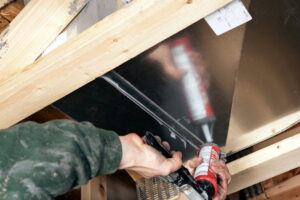When homeowners hear about duct sealing in Aberdeen, KY, their first instinct is often to grab a roll of duct tape. After all, the name itself suggests it’s the perfect solution, right? Unfortunately, that’s far from the truth. At Premier Heating & Air, we frequently see the aftermath of DIY duct sealing attempts using duct tape, and we can tell you with certainty that it doesn’t work. In this post, we’ll explain why duct tape is ineffective for sealing ductwork, why DIY fixes usually fail, and how professionals properly seal ducts for maximum efficiency.
Why Duct Tape Fails for Duct Sealing
Despite its misleading name, duct tape is one of the worst materials to use for sealing air ducts. Here’s why:
- Heat Causes Adhesive Breakdown – Your HVAC system pushes heated and cooled air through your ductwork, and over time, temperature changes cause the adhesive on duct tape to deteriorate. Once the adhesive dries out, the tape peels away, leaving gaps and leaks.
- Lack of Long-Term Durability – Even if duct tape appears to hold up initially, it quickly degrades under the constant exposure to air pressure and temperature fluctuations. In a few months, that “fix” you applied will have failed.
- Code and Safety Issues – Building codes do not approve traditional duct tape for sealing ducts. Instead, professionals use specialized materials that are tested for HVAC applications.
The Risks of DIY Duct Sealing
Some homeowners attempt to fix duct leaks on their own, thinking it will save them money. Unfortunately, these DIY fixes often do more harm than good. Here’s why:
- Hidden Leaks Remain Unfixed – Most homeowners can only access a small portion of their ductwork. The majority of leaks occur in areas that are difficult to reach, such as attics, crawl spaces, and behind walls.
- Inefficient Seals Waste Energy – Without the right materials and techniques, DIY sealing won’t be airtight, leading to continued energy waste.
- Compromised Indoor Air Quality – Poorly sealed ducts can pull in dust, allergens, and contaminants from unconditioned spaces, lowering the air quality in your home.
- Increased Strain on Your HVAC System – Air leaks make your HVAC system work harder to maintain comfortable temperatures, leading to higher utility bills and unnecessary wear and tear.
How Professionals Properly Seal Ducts
At Premier, we use industry-approved techniques to ensure your duct system is sealed correctly and efficiently. Here’s what our process looks like:
- Thorough Inspection – We start with a comprehensive ductwork inspection to identify leaks and inefficiencies. This includes checking joints, connections, and any problem areas.
- Proper Sealing Materials – Instead of duct tape, we use mastic sealant and foil-backed HVAC tape (UL-rated). These materials are specifically designed to withstand temperature changes and air pressure.
- Final Testing for Airflow Efficiency – After sealing, we test the system to measure airflow improvements and ensure a proper seal.
Don’t Rely on Duct Tape—Call the Pros at Premier
If you suspect your ductwork has leaks, don’t waste time with temporary fixes like duct tape. Instead, call the professionals at Premier Heating & Air. Our team has the expertise and equipment to ensure your duct system is properly sealed, saving you money and improving your home’s comfort.
Contact us today to schedule a duct inspection and start enjoying the benefits of a more efficient HVAC system!


